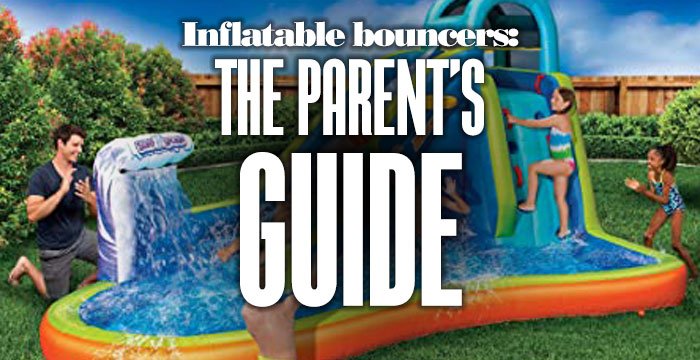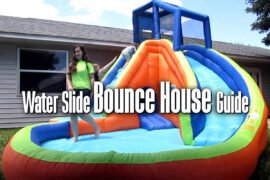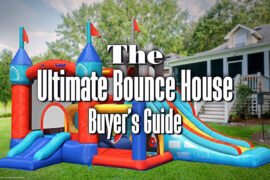Inflatable bouncers aren’t exactly new, but they’ve never been more popular than they are now, especially among families with children. They’re becoming increasingly prevalent in yards and driveways all around your area, and they’ve become a standard at many festivals and carnivals. This guide to inflatable bouncers attempts to provide you with all of the information you’ll need to make an informed decision.
Inflatables’ popularity is partly due to the fact that they are a lot of fun! When you watch a youngster pass by an inflatable, you’ll see what I’m talking about. If you have kids, you know what I’m talking about – they’ve undoubtedly begged you a hundred times to hop in a bouncer.
From the parent’s standpoint, bounce houses are a reasonably safe, moderately-priced form of entertainment that children enjoy. I know several parents who have purchased inflatables, and none of them regret it. The majority of us own more than one! As parents, We had those times when we need to put things on cruise control. Inflatable bouncers may be a friend in your corner who can assist you corral your kids and getting their energy out in a semi-functional manner, despite what the name implies.
Despite their rising popularity, many parents are unfamiliar with the fundamental principles of inflatable bounce houses, such as safety precautions, best practices, and purchasing guidelines.
The Fundamentals
Basic Bounce House Principals
A bounce house is a large air-filled cushion that runs on a continuous air supply. A bounce house keeps proper pressure after it is initially inflated by releasing some air from its seams, which is then replaced with fresh air from the blower motor.
Continuous Air Flow
The inflatable is inflated and then deflated repeatedly until the air supply is disconnected. (Or, in the case of a blower, until you switch off the electricity to the unit.) The blower adds to the bounce of the bouncer as your children jump on it. Taking great care of both your inflatable and blower will guarantee dependable performance and long life.
It’s good to have a blower that matches your Bounce House when purchasing a new one. The blower must be plugged in the entire time the bouncer is inflated, and it’s usually suggested that you use an extension cord because doing so might reduce the amount of electricity your outlet can consume. When a decrease in power is noticed, the unit loses more airflow, bounce, and stability for kids using it.
The tube, constructed of the same material as the house, will be connected to the blower to fill up your bounce house. Ensuring that the tube is fully extended with no kinks or bends will give you the best bouncing experience.
Material
Bouncers are typically made of vinyl, nylon, or similar material with varying amounts of cross-hatching and other procedures designed to strengthen the material. Residential versions are generally made of much lighter materials than their heavy-duty commercial counterparts, but you can usually locate a brand that is reliable for your family.
Setting Up Your Bounce House
Depending on the model, setting up your bounce house might need the assistance of one or more individuals. A typical residential bouncer weighs about 30 to 60 pounds and is difficult to handle since it is so inconvenient when rolled up. You’ll be ecstatic to plan ahead of time if you expect assistance, especially your first time.
Placement
In general, placing your bouncer on a flat, grassy surface is the safest position. You want as much open area on all sides of the bouncer as possible, and you want to make sure that all entryways and exits are accessible. When children play on these toys, they go wild – They won’t be watching where they’re going as they circle the unit since they’ll be so delighted.
You shouldn’t have to worry about the bounce house injuring grass while it’s in use, but you should take care to avoid trees, bushes, and shrubs that might damage the Bounce House. It’s critical to take down the bouncer and store it away after you’re done using it to protect your grass from damage. This will allow your grass to breathe and heal itself.
Blower Operation
Keep an eye on the connection where the blower is attached to the unit. There will be a supply tube that is several feet long, that must be kept straight and kink-free during usage. You’ll also need to connect the blower to a power source (ideally, without the use of an extension cord). When selecting where and how to position your bouncer, remember to think about these things. Prepare ahead of time, and your children will have a safe and enjoyable experience.
It will typically take between 60 seconds and 3 minutes for your bouncer to inflate once the blower is connected fully. The blowers propel a huge quantity of air in a short amount of time. You’ll be shocked at how quickly some of these devices can inflate.
When the blower is in use, you will hear air escaping from the seams. Remember, the blower must be switched on at all times, and a large part of the air produced eventually leaks out through the seams. It’s all normal, and there’s rarely anything to be concerned about. Trust your instincts – This way, if there’s ever a genuine problem, you’ll be able to tell.
Anchoring
A bounce house usually has four to eight straps and a set of stakes to secure it to the ground. When driving through the stakes, exercise extreme caution. Covering the heads of the stakes after they’ve been pushed into the earth is another thing I strongly advise you to do. This will assist in transforming any serious harm into a minor scratch if a youngster runs into one.
A concrete or asphalt slab is a less desirable but completely safe option for placing your bouncer. When you have to use this method, you’ll need to put down a tarp or some other type of mat beneath the bouncer. This isn’t about the bouncer; vinyl can easily withstand being placed directly on a hard surface. It’s more about the children. Having a large tarp beneath the bouncer ensures that you suffer only minor scrapes, not skinned knees.
When building on concrete, it’s necessary to have some mechanism to keep the inflatable in place. The bouncer will be secured to the ground using several straps that are typically employed with stakes. This is when you must get a little creative, but it is not something you can skip over. To keep the unit securely to the ground, you must utilize sandbags or another weight-bearing method and attach them to the anchor straps. You cannot overlook this when setting up on a hard surface.
Indoor Use
Some bounce houses are small enough to be set up indoors. A typical eight-foot ceiling is sufficient for most people who fall under the residential category. It’s essential to ensure there is enough clearance for your children to bounce – mine can typically jump 2-3 feet off the surface of the bouncer, so make sure there’ll be enough headroom for them to leap. All of the customer evaluations you’ll find on this website will indicate whether a bouncer can generally be utilized indoors. Still, common sense prevails, and your results may vary.
Safety and Proper Usage
The secret to getting genuine enjoyment from your bouncer is to follow basic standards and read the manual, as with any other item in life. Your kids will avoid bumps and bruises and genuinely enjoy the bouncing experience when you put it that way.
When it comes to inflatable bouncers and it’s safety, the consensus is that they are safe and appropriate for kids to use when properly utilized. Inflatable bounce houses are generally much safer for children than other similar equipment such as trampolines and playground equipment.
General Rules
When your youngsters use a bounce house, you can follow several basic common sense guidelines. Kids must take off their shoes, empty their pockets, and remove jackets or other items with zippers before being allowed into the space. When you’re inside the bounce house, no pushing and shoving, keep an eye on the kids and be careful of others. If you’re clear and stern, kids usually follow the instructions.
Weight Limits
The total weight limit and the individual weight limit of each kid are crucial guidelines that must be followed. You should follow your owner’s manual instructions to ensure that the bouncer is not damaged from being overloaded.
On the other hand, manufacturers tend to be overly cautious when it comes to weight restrictions. At the end of the day, you should be able to tell what each bouncer can handle just by looking at them. If adults use them, you’re generally secure if you’re only in there for a brief period. It’s not advised to leap while in there, but these things are essentially large air mattresses at the end of the day.
The number of children who can jump simultaneously is also shown on each bouncer. When it comes to weight restrictions, common sense should come into play – they must be cautious with these numbers too. It’s usually OK to allow one or two more kids in. Just don’t go crazy and double the amount, and you’ll be fine.
Adult Usage
Adults are sometimes concerned about whether or not they can enter the bouncer. It’s crucial to pay attention to weight restrictions, but most adults will be OK going inside. As long as you don’t leap with your children, everything should be just great.
Weather and other Hazards
To avoid endangering your bouncer, be cautious about putting it in hazardous circumstances. It’s crucial to ensure that your unit is firmly attached to the ground. Setting it up in windy or stormy weather, on the other hand, can be quite dangerous and result in far more damage than good. Again, common sense plays a vital role in ensuring that your family has a good time.
The essential regulation for a bounce house or inflatable slide is that there must be an adult on hand who is actively monitoring the situation at all times. Most of the mishaps I’ve witnessed in a bounce house could have been prevented if an adult had provided more active supervision. It takes more work at the outset, but you’ll have a more pleasurable experience overall.
Storage and Repair
It’s usually quite simple to store your bounce house. If you buy a new unit, it will usually come with a canvas storage bag that you may use for long-term storage.
If you bought your bouncer secondhand or didn’t receive a storage bag, you can usually find a plastic storage container that will fit your model. Check with your local Walmart or Target. There are several sizes to choose from, so it should be simple to discover the appropriate one for you. If you choose to go this way, I strongly advise getting a container with wheels and one that feels robust enough to do the task. Remember, these items may become quite heavy.
It’s critical to roll your bouncer back up carefully and slowly, regardless of the container you use to store it in, to ensure that it is smooth and straightforward to store. Allow the device to deflate completely. It may take a few minutes, depending on your unit. You may need to assist the process by raising any bouncer components that keep the air tubes closed. When folding it up, leave the air hoses open.
When the device is completely deflated, be sure it’s totally stretched out on the ground or floor. It’s time to begin folding it now that it’s completely stretched out. In general, you should fold it in half two to three times. Begin by folding the bouncer up. Roll it until you have an excellent, compact package. It’ll be considerably simpler to return this bundle back into the storage container than it would be if you just bunched everything up or rolled it without folding.
Buying Advice
The wide range of options may cause you to doubt the whole process. Where and how you plan to use the bouncer is crucial in ensuring your happiness. Once you understand this, you may identify the available characteristics at a specific size.
Size and Space
Choosing a bouncer is only half the battle. It would be best if you first considered where you’d use it the most. Using it outside, of course, gives you far more area to work with; nevertheless, bear in mind that many bouncers can now be stored indoors.
Once you’ve decided where you’ll put it; most parents tend to purchase the most significant unit feasible to provide their children the maximum enjoyment. This is entirely dependent on the features – if you prefer a giant slide or a basketball hoop, you’ll probably give up a more significant bounce area for it – but I can’t think of a single parent that wishes they’d bought a smaller bouncer.
Features
One or more essential characteristics are likely the driving force behind your purchase. These days, inflatables come in various shapes and sizes, from typical bounce houses to inflatable water slides and even complete obstacle courses.
Another thing to think about is whether you want younger children and adults to use the bouncer. To be clear, when I say “bouncer,” I mean to utilize it in its absolute sense. If the parents are jumping and sliding, you’ll need to know this before making your purchase. While most retail models can accommodate one or two persons who crawl in to assist; they are not suitable for jumping in.






